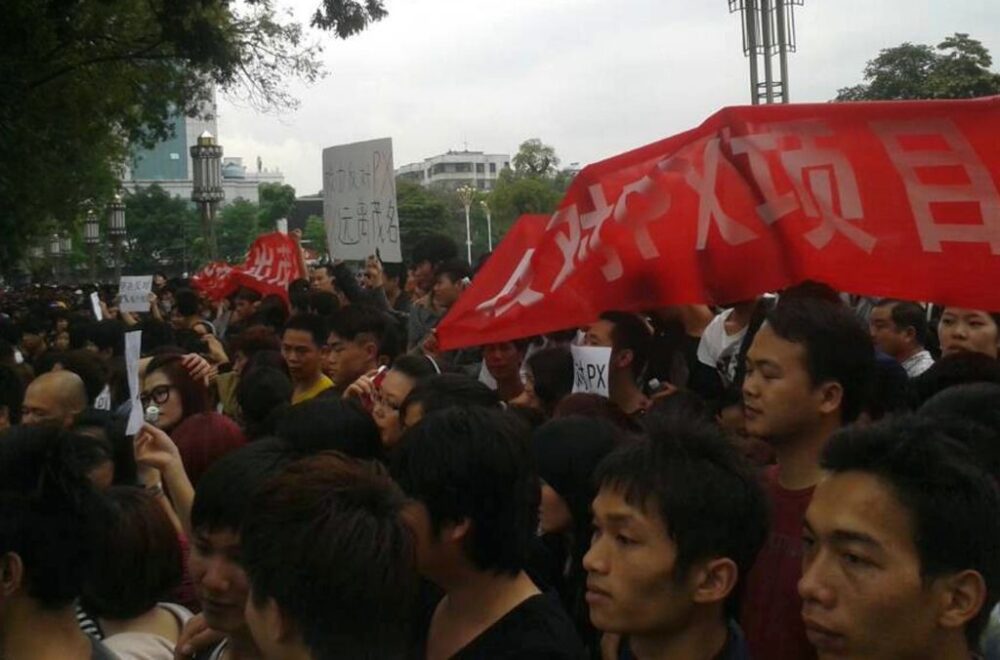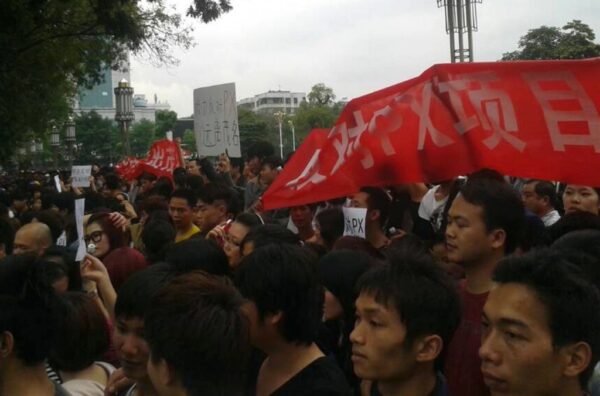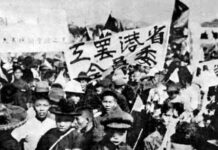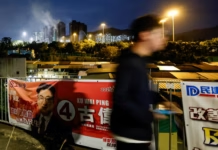
China perspectives 2020
The following document was approved unanimously by the 4th congress of the CWI China/Hong Kong/Taiwan section held in December 2019.
China is moving into a period of revolutionary shocks and upheavals. This is shown by the unprecedented mass movement in Hong Kong, in which there are revolutionary features, alongside less developed features and a lagging behind of mass consciousness in certain key respects. This is especially over the need to topple the dictatorship as the only way to achieve even the partial democratic demands of the movement. The masses still feel the CCP regime is too big and strong to overthrow and therefore cling to the illusion that a local democratic space can be created and maintained in coexistence with brutal autocratic rule in the rest of China.

Having reached the milestone of 70 years in power, the longest lasting of any contemporary ‘Communist’ regime, and rising to the status of an economic and military superpower, the Chinese dictatorship nevertheless looks to the next period with dread. This was summed up by Xi Jinping’s speech at the end of 2018, when he warned of “unimaginable terrifying tidal waves and horrifying storms” in the years ahead. In fact, the regime finds itself in something closer to a “perfect storm”, combining threats from many directions: the sharpening US-China conflict which will shape global events for years to come, mass revolts on China’s ‘periphery’ i.e. Hong Kong, Taiwan and Xinjiang, where the CCP attempts to lock down an entire population, and an accelerating economic downturn aggravated by the world’s biggest debt burden. None of these problems are short-term. Rather they are long-term crises that will frame the future development of China and the CCP regime.
Consequently, the regime of Xi Jinping has entered a phase of deep crisis. We argued against those who merely repeated the propaganda ministry’s line about “the strongest leader since Mao Zedong”, explaining that this exaggerated Xi’s position. More commentators are now coming to realise the Chinese regime, because of Xi’s extreme concentration of personal power, is increasingly vulnerable.
Xi has presided over a succession of miniature “civil wars” within the state, the security apparatus, army and the leading groups controlling the state-owned enterprises, with the aim of recentralising power within the state. In this sense, Xi is the “anti-Deng”, and his program is to reverse Deng’s decentralisation of powers to the regions and within Beijing’s power structures. This program was seen as vital to restore the power of the state to intervene and overcome creeping paralysis, which defined the rule of Xi’s predecessors. Today, however, paralysis is reasserting itself. Not for nothing is Xi now being compared with Leonid Brezhnev, the leader of the USSR, whose rule was synonymous with stagnation. The changes introduced by Xi are revealed as largely cosmetic, magnified by an immense personality cult and deafening levels of propaganda.
The three main elements of “Xiism” are: reinvigorated authoritarian rule and central control (complete rejection of ‘Western’ political reform), increased nationalism and promotion of China’s great power status through global initiatives (such as the Belt and Road Initiative, BRI), and an upgrading of state capitalism (combining a high degree of CCP control with more liberalisation to ‘fix’ the system’s inefficiencies: colossal waste and record amounts of debt). On all three fronts – authoritarian rule, nationalism and (limited) economic reform – the CCP regime is meeting increasing resistance.
Global capitalism is pushing back against China’s international ambitions and the BRI. The crisis of capitalism renders the regime’s economic reform plans unworkable (forcing even greater reliance on state capitalist measures). Growing discontent throughout Chinese society over the suffocating lack of democratic rights and growing inequality threatens to explode – which would put Xi’s massive machinery of “stability maintenance” to the test in a way not seen before. Hong Kong is just a foretaste.
The tenacity and resilience of the Hong Kong mass struggle has therefore shaken the CCP regime more than any event in the post-1989 period. In China the regime has typically dealt with short bursts of protest, flare-ups in one area or region, workers’ strikes that rarely last more than a few days. Its repressive machine has been ample to these tasks. Hong Kong’s unprecedented resistance, its truly mass character, creativity and stamina, over more than half a year, raises a terrifying spectre over the heads of China’s rulers.
If similar mass discontent erupts in one or more major mainland city, how would the regime cope? The draconian philosophy of Xi Jinping, of zero tolerance towards dissent, is more effective as a deterrent or threat than to actually use it against a mass movement. Tear gas in the hands a hated regime can cause more problems than it solves.
As we have seen in Hong Kong and in other mass revolts during 2019, such as in Chile and Iraq, repression can so anger the masses as to drive these movements to even greater heights. “I predict that the stability maintenance machine of the Chinese Communist Party dictatorship won’t stay effective for very long,” noted Hong Kong scholar Willy Lam. The CCP is building an unprecedented high-tech version of Orwell’s ‘Big Brother’ state. Smartphones have been weaponized to control and monitor the population, with facial and voice recognition technology. DNA and biometric harvesting is taking place on an industrial scale to track and control the population. But this involves high stakes risks for the CCP as expressed by Beijing-based dissident Zhang Lifan: “The government’s use of high-tech social controls creates some difficulties in that once it faces resistance, or in the event that high-tech controls fail, the state will face the eventuality of total collapse.”
Yet, especially in the short term, there is no prospect of the CCP regime changing course to adopt a softer line or making democratic concessions. The capitalists, globally and within China, and this includes the CCP-linked oligarchies that are the core of the Chinese ruling class, can at a later stage be driven to the conclusion that the hardline authoritarian doctrine of Xi Jinping – of “absolutely no mercy” as he is reported to have told Xinjiang’s CCP bosses – is counterproductive. But given the extreme weakness of the CCP’s liberal wing (in the political sense), a change of direction away from today’s hardline policy would necessitate a major rupture, a ‘palace coup’ or governmental crisis, and most likely Xi’s removal from power. The danger from the standpoint of the ruling class is that, as history has shown, attempts to reform at the top can sometimes be the trigger for revolutionary movements from below.
At the end of a year of setbacks and humiliations, the Hong Kong district council elections were the biggest embarrassment yet for Xi’s regime. Beijing completely misjudged the mood and seems to have been intoxicated by its own propaganda, unbelievably expecting a victory for the pro-Beijing camp. Instead, a six-month cannonade of tear gas and rubber bullets from the CCP’s police force in Hong Kong produced a record 71 percent turnout, sweeping the pan-democrats and other opposition forces forward to take 87 percent of the seats. The CCP’s giant propaganda machine was paralysed, shocked and voiceless for almost three days, unable to explain an election result it had convinced itself was impossible. This episode says a lot more than just how disconnected the Chinese regime is from the real situation in Hong Kong. Why should anyone believe it has a firmer grasp of the real situation on the ground in China? No amount of censorship can fully keep this crushing defeat for the CCP’s proxy parties from becoming known in mainland China. At the top, where of course the full scale of the fiasco is already known, this can only stoke the internal power struggle and raise doubts about the political strategy and general competence of Xi’s ruling group.
The elections in Taiwan on 11 January could be an even bigger, more humiliating setback for Xi Jinping, given also the more important character of these elections. It is unlikely Beijing will be so badly disorientated this time around. But given the likelihood of a major win for Tsai Ing-wen, based almost entirely on rejection of the CCP’s authoritarian system, and fuelled by the defiant spirit of the Hong Kong protests, this will pose major new problems for Xi’s regime. For the strategic conflict with US imperialism, within which Taiwan is a crucial ‘domino’, the CCP has now realised it must play a long game. But the bullying, ultimatist position of Xi, under pressure not to show ‘weakness’, limits the range of options for the Chinese regime. Not for nothing there are growing voices being raised within China, also in relation to Hong Kong, for pragmatism – an implicit criticism of Xi’s approach.
The CCP fears the movement in Hong Kong, as it fears all mass movements and “instability”, but mostly because of the potential for this to spread to mainland China. Although a direct ‘copy cat’ movement is unlikely, the Hong Kong mass protests will become a vital reference point when the mainland masses move into struggle against state repression. That would fundamentally change the situation and pose an existential threat to CCP rule which Hong Kong by itself does not pose. Above all the CCP fears a movement of the working class in China, as was the case in 1989, when the student-initiated mass protests became the trigger for the emergence of an independent workers’ movement. By downplaying and refusing to recognise the potential role of the working class in the Hong Kong struggle, the moderate pan-democrats and their allied trade union leaders have rendered an unintended service to the CCP and Hong Kong government, complicating and limiting the ability of the mass struggle to rise to another level. A workers’ movement in Hong Kong combining revolutionary anti-authoritarian demands with anti-capitalism and demands for workers’ rights would wield much greater influence in mainland China. A key new development in the mass movement, after six months of struggle, is the turn of a section of the masses towards the concept of trade unionism, with new union groups sprouting up, strikes erupting, and slogans in favour of trade unions on demonstrations.
The explosion of revolt in Hong Kong is payment for the brutal authoritarian policies of Xi’s regime, slavishly implemented by the CCP’s local proxies, piled upon the social catastrophe of extreme neo-liberalism. Despite a succession of humiliations and forced retreats in the face of the masses’ tenacity, the regime shows no signs of a re-evaluation or change of direction. Not for Hong Kong, not for Taiwan, and not within China itself.
Instead the ruling group is doubling down on its hardline approach, ploughing even greater resources into its repressive capacity, building a model “techno authoritarian state”, and extending new methods of control and surveillance even over the elite layers of the CCP-state. This was confirmed at the Fourth Plenum in October, which announced no new policies but “much more” of the same. This superficial show of strength in fact reveals growing weakness and insecurity at the top, with more than a hint of paranoia. Devoid of ideas and options, Xi’s regime repeats itself ad nauseum. The message is even greater “control” by the regime with Xi at its “core”, but in reality this control is slipping rather than gaining strength. In Hong Kong, faced with a wall of resistance the regime, “adopted a strategy to procrastinate in the absence of any better ideas,” said Beijing-based commentator Wu Qiang.
After waves of strikes in China in 2018 and the remarkable Jasic struggle, the regime’s repression induced a temporary downturn in workers’ struggle. But as in Hong Kong, repression only accumulates more anger and leads to a bigger wave of struggle at a later date. 2018 represented an important turning point because an advanced layer of youth in China gained experience in struggle and greater understanding of the nature of the regime (fewer illusions in reform). This is similar to the Umbrella Movement in Hong Kong in 2014.
Xi’s numerous setbacks in the international power struggle with US imperialism is seriously damaging his ‘strongman’ image. The nationalistic, triumphalist propaganda surrounding the BRI, and claims of the technological dominance of major Chinese companies has suffered a backlash and loss of credibility. The change in consciousness is shown by mass reactions on China’s social media to the one-year anniversary of the detention of Huawei heiress Meng Wanzhou: Anger over Huawei’s mistreatment of its employees overshadowed any nationalistic indignation over her treatment by Canadian and US authorities.
The BRI project faced setbacks even before the China-US conflict escalated since July 2018. The debt trap problem for small countries, especially South and East Asian countries like Sri Lanka, Pakistan and Philippines, already caused waves of project cancellations. The anti-BRI campaign of Western imperialism means governments in neo-colonial countries will try to balance between the superpowers and will see increasing splits between pro-US and pro-China political factions. After four years of increases, Chinese-led new contracts and direct investments in BRI countries declined to US$116.4 billion in 2017 from US$143.2 billion in 2016. The total value in the first-half 2018 was only 42 percent of the same period in 2017.
The need to drum up Han Chinese nationalism in order to create a ‘strongman’ image and consolidate Xi’s power within the CCP-state makes its hardline approach towards Xinjiang irreversible. The unprecedented repression, racist apartheid-style laws, and mass incarceration in Xinjiang, shows how the CCP-state has created a crisis from its own ultra hardline policies. Even local officials who are more subjected to mass pressure on the ground have shown unwillingness to implement some of the repressive policies causing divisions within the state apparatus. The recently leaked 400 pages of internal CCP documents reveal that 12,000 local CCP officials have been investigated for not pursuing the crackdown vigorously enough. The leaking of these documents to Western media is itself a sign of discontent within the state apparatus about these policies.
China’s economic slowdown
China’s economic performance is a crucial factor for working out perspectives for the coming period. Based on official data, GDP growth has fallen to its slowest pace in almost thirty years. There has been an uninterrupted slowdown in quarterly growth rates from an average of around 9 percent from 2011 to 2016 to around 6.5 percent since 2016. Recently Premier Li Keqiang admitted that it would be “very difficult” to maintain GDP growth at six percent, in remarks that were interpreted to mean growth could drop below 6 percent in the final quarter of 2019. Most international forecasters are predicting sub-six percent growth for China next year and beyond.
When we consider that the real rate of growth could be significantly below the official figures, this brings home the point that under Xi Jinping the phase of rapid Chinese economic expansion has come to an end. A 2019 study by scholars at the Chinese University of Hong Kong and University of Chicago concludes that Chinese GDP data was exaggerated by an average of 1.7 percentage points per year from 2008-2016. If correct, this would make China’s economy about 12 percent smaller than official figures suggest. This study compared GDP data from China’s 32 regions with the national statistics and found discrepancies suggesting significant manipulation of figures. At least three provincial governments have been publicly named and shamed for falsifying their GDP data: Liaoning, Inner Mongolia and Tianjin, but there are many more cases at the level of city governments.
The halving of official GDP growth rates since 2007 does not give the whole picture. China’s economic woes go much deeper. In 2007, then premier Wen Jiabao famously spoke of the four “uns”: China’s economy was “unstable, unbalanced, uncoordinated and unsustainable”. How much has really changed since then? It could be argued that today the problems identified by Wen have grown more severe.
This is especially in the aftermath of the monster stimulus program of 2008-9, which Wen himself helped to launch, which shifted China onto a trajectory of uncontrollable debt accumulation. This has been followed by a succession of smaller but by world standards still gigantic stimulus rounds injecting trillions of yuan of credit into the economy. This was especially the case in 2015, when the economy may have come close to a financial ‘heart attack’, although this was of course never revealed. China in this period has become addicted to ‘life support’ in the form of massive credit injections. This mirrors in a different form the processes in the rest of the capitalist world, where ‘QE’, zero or negative interest rates, and other unprecedented government interventions have propped up the world’s major economies. Some economists argue that if stimulus spending is subtracted, China’s economic growth over the past decade would be zero.
“In 2008, socialism with Chinese characteristics saved capitalism,” argues scholar and prominent nationalist Hu Angang, referring to Beijing’s first big stimulus package and its effects in cushioning global capitalism against the ‘Great Recession’. The full impact of these policies inside China is only becoming clear now when it is no longer possible for the CCP regime to sustain massive further credit expansion without guaranteeing a financial crisis further down the road. “China has undertaken around half of all global stimulus since 2008, in effect creating sub prime on steroids,” noted a report in the Financial Times.
The debt mountain is once again growing in China after a brief pause. Xi’s regime has abandoned its campaign, launched in 2016, to reduce leverage and curb the growth of the shadow banking sector. This economic u-turn was forced by the sharp slowdown in the economy which has been further exacerbated by the trade war. China’s total debt-to-GDP ratio rose to 303 percent in the first quarter of 2019, from 297 percent a year earlier. With nominal GDP growth (before adjusting for inflation) currently running at 8 percent while total credit is growing at a rate of 11 percent, the debt-to-GDP ratio can only worsen.
“China’s banking system is twice the size of America’s” proclaimed the South China Morning Post, reporting that China’s banking system now has combined assets of US$40 trillion dollars, in a US$14 trillion economy (China’s 2018 GDP), compared to around US$17 trillion in the US banking system, with a GDP of US$20.5 trillion. “The massive size of China’s banking system is less a cause for celebration than a sign of an economy overly dependent on bank-financed investment, beset by inefficient resource allocation, and subject to enormous credit risks,” says Eswar Prasad, a former China head of the International Monetary Fund. The neo-liberal wing of global capitalism (and their echoes in the CCP) want to speed up financial ‘reform and opening’ of China’s financial sector, when in fact this ‘cure’ could be even worse than the ‘disease’ in that it could precipitate the financial crisis they want to avoid. But the CCP’s current more ‘controlled’ approach, with some partial liberalisation and openings to foreign capital (which it also hopes to exchange for concessions in the trade war), is no guarantee a banking crisis can be avoided.
The deepening crisis in the regional banking sector could signal the beginning of a much bigger shakeout. These ‘small’ banks make up one-sixth of China’s banking system with assets of around US$6 trillion, and therefore their combined impact is significant. At least three banks have been rescued by the government in 2019, in the provinces of Inner Mongolia, Liaoning and Shandong. In the case of
Baoshang Bank in Inner Mongolia, it was nationalised outright, the first nationalisation since 1998 and “a dramatic break with precedent” according to Bloomberg News. In the other two cases the state brokered rescue operations involving capital injections and partial takeovers by other companies and banks. In Liaoning, a region that has suffered outright recession (negative growth) in recent years, and in Henan, there have been runs on local banks forcing authorities to intervene. The government is scrambling to shore up this sector to prevent regional bank failures feeding through to the bigger banks. The latest China Financial Stability Report produced by the central bank (PBoC) in November 2019, lists 586 regional banks as “high risk”. That’s one in seven of China’s 4,379 banks. Over 10 percent of these institutions failed a stress test conducted by the PBoC in 2018.
The regional banking crisis is closely connected with the worsening financial crisis of China’s local governments, which in turn is connected with the fragile housing market: Land sales are the main source of local government revenue and most bank loans are tied to property. The number of defaults by local government entities has rocketed in 2019.
China’s official local government debt rose to 36.9 percent of GDP at the end of 2017, from 16 percent in 2013. But the IMF has arrived at a much higher figure by including the off-budget borrowings of local government financing vehicles (LGFVs). On this basis, the government debt-to-GDP ratio will have grown from 48.1 percent of GDP in 2013 to 91.6 percent in 2023. Beijing’s ‘solution’ has been to massively increase the issuance of local government bonds in what amounts to a disguised bailout of the local government sector, with debts shuffled from one set of books to another. Today’s special local government bonds are mostly bought by the same banks that hold the existing debt. With this year’s quota already reached, the central government recently allowed local governments to sell part of 2020’s bond quota. Rather than a solution this is another example of financial trickery to buy more time.
The biggest ‘grey rhino’ in the economy is the housing market, which has swollen to a market value of US$65 trillion, which is twice the combined size of the G7 economies’ GDP (United States, Japan, Germany, France, Britain, Italy and Canada). This is almost five times China’s GDP, representing a speculative bubble that far exceeds even the Japanese property bubble of the 1980s. Chinese economic and political analysts use the term ‘grey rhinos’ to identify “highly probable, high impact yet neglected threats” whereas ‘black swans’ are crises that supposedly occur “randomly and unexpectedly”. However, the current movement in Hong Kong has been dubbed a ‘black swan’ event, when in fact it was an inevitability – a political ‘grey rhino’.
China’s tier 1 cities have some of the highest house-price-to-earnings ratios in the world. To buy an average priced apartment in China’s capital costs 45 years of the median salary, compared to eleven times in New York and 22 times in London. Despite building more houses than any other country, the housing affordability crisis in China will become a major trigger for social unrest and workers’ struggles, as wage increases are eaten up by housing costs. At the same time, the monstrous property bubble, and its connection – like Siamese twins – to the banking system increasingly limits the CCP’s policy options.
The regime is walking a tightrope between looser monetary policies, which would risk igniting a new upsurge in house prices, or tightening measures that could cause the market to implode. This is a choice between the bubble bursting now or later. According to Shanghai-based economist Andy Xie, “It [the property bubble] can keep going only if the debt continues to rise faster than GDP. Any deleveraging campaign, which the country tried a couple of years ago, would pop the bubble.”
This explains the failure of the stimulus policies of the past year to gain traction and kick-start economic growth. Manufacturing and most other measures of economic activity have continued to fall every month of 2019, with the exception of March-April, which coincided with the main part of the stimulus measures announced during the NPC meeting. Consumer spending continues to underperform and is not compensating for the loss of exports (from the trade war and slowdown in global growth) and falling investment (from corporations preferring to use new credit to pay down their debts).
China’s consumer spending is just 39.4 percent of GDP, which is much lower than most advanced capitalist countries and lower even than India (59.3 percent) and Brazil (62.4 percent). The crippling cost of housing, followed by the high cost for education and healthcare, are major factors that suppress the spending power of the population.
This is also reflected in the sharp increase in household debt, in a country that previously was world famous for its high household savings. The Washington-based IIF calculates that China’s household debt-to-income ratio rose to 92 per cent at the end of 2018, from just 30 per cent in 2008. This means household debt levels in China have overtaken Germany (86 percent) and are close to the levels in the US (97 percent) and in Japan (100 percent). The South China Morning Post warned, “The rapid rise of leverage and household debt has sparked concerns China could be galloping down the same road to ruin followed by Japan in the early 1990s and the US in 2008.”
This makes the government’s stimulus measures harder to implement – like “pushing on a piece of string” as the economist Keynes remarked. Like the corporate sector refusing to invest, individual households are reacting to stimulus not by increasing consumption but rather by paying off their debts. With the reappearance of deflation (falling prices) this year at the factory gate, although this has not yet filtered through to consumer prices, which are at an eight-year high due mainly to the pork crisis, China’s weak consumer spending can get weaker still – as Japan’s experience since the 1990s can testify.
This combination of economic pressures has generated enormous debate about why the regime’s stimulus measures, which are certainly not small, are failing to produce the desired rebound in economic growth. Many economists expect more radical stimulus policies in 2020. But this will further aggravate the debt crisis and may only confirm that the economy is in the grip of “stimulus fatigue”.
The CCP regime, like the rest of global capitalism therefore finds its options limited by a ‘depleted toolkit’. While the features of Chinese state capitalism are not exactly comparable with those of Western capitalism, both have relied on massive injections of credit to sustain a weaker rate of growth over the past decade. A new global recession will ask questions for which they have no answers. China can continue to create money “out of thin air” as the Financial Times described this, making the most of state control of the banks and capital controls, but at a certain point this mechanism will reach its limits. The first tremors of this process became apparent in 2019 with the crisis in the regional banking sector.
For revolutionaries it is clear that the next period will bring unprecedented social, economic and political upheavals. The current policies of the CCP regime are driving relentlessly towards crises and social conflict on a grand scale. As we have experienced through the mass struggle in Hong Kong, the key task is to politically and organisationally prepare the forces of Marxism to intervene as pioneers of the new workers’ movement with socialist policies which the situation urgently demands.



